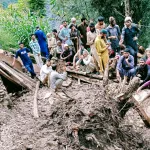Since the time human beings left the moniker of ‘cave dwellers’ tagged to them millions of years back , two very distinct animals in the form of a ‘faithful dog’ & ‘beasts of burden’ be it the oxen, horses or yaks/ camels have stood the test of times in supporting the transformation of lives of the former. The change from a ‘cave dweller ‘ to that of a ‘settled life’ in the trajectory of human development has had its unique discoveries; one of them being the ‘Bactrian camel’.
A native to central Asia , rather the ‘steppes’ that are in abundance over there , the Bactrian camel ( camelusbactrianus ) named after the ancient region of Bactria, now part of Afghanistan, Uzbekistan, and Tajikistan was first domesticated over 4000 years ago. The recent but formal induction of this hardy beast of burden by the Indian army ( IA) for logistics and patrol duties along the high –altitude , disputed border with China in eastern Ladakh where even the ‘all-terrain vehicles’ ( ATV) and traditional mules fail should have been done long time back.
I just can’t figure out that why it took more than 63 years for this formal induction of ‘Bactrian camel’ into the Indian Army (IA) since the time two Asian giants came face to face and made the otherwise tranquil Sino-Indian border a live wire? Any way that is not the centrality of my write up, with the focus only on the sine quo non of the traditional cold desert ‘ladakh’ for carriage of loads from place to place.
The ‘Defence institute of high altitude research’ ( DIHAR) –a defence research and development organization ( DRDO) unit –working in collaboration with the IA’s remount & veterinary corps ( RVC) which began trialing these unique camels in Ladakh in 2023 , handed over 14 of them to the Leh based XIV ‘Fire and fury corps’ last month. Equipped with custom –engineered harnesses and modular load –carrying frames , developed by the ‘Army design bureau’ and DRDO affiliates , these camels will now undertake high altitude transportation and recce missions with their handlers ,along remote and rugged frontier stretches.
Each ‘Bactrian camel’ is tasked with carrying between 170 to 180 kgs of supplies –including food, ammunition , medical kits, surveillance & communication and sundry other materials over altitudes ranging from 14,000 to 17,000 feet or more thereby successfully executing terrain monitoring duties. Towering at an imposing 7 feet at the hump and weighing 600 to 1000 kgs these hardy beasts possess formidable strength and stamina with incalculable power to inflate their lungs with the rarified air of Ladakh, thus propelling them forward to their destinations.
The prelude & postlude to Galwan clashes in May/ June 2020 in eastern Ladakh showing the ATV’s ( all-terrain vehicles) of Chinese army in various videos available on the ‘You tube’ is testament enough for the terrain favouring them on their side of the LAC. But that is not the case with the Indian side which has some of the worst terrains obtainable in the world, thus making this Bactrian camel the only catalyst to lug heavy loads leaving aside mules and air transportation.
It had been a constant refrain of the logisticians spanning from the armed forces to that of the scientists from the famed DRDO that mountains were the real ‘acid testers’ on which lay the template for formulation of a sound logistics plan. And here was the real ‘pack animal’ in the form of a ‘Bactrian camel’ that could heave the burden of a marooned logistician. In Ladakh, an improvement in the road infra post ‘Galwan clashes’ of May/June 2020 notwithstanding, toops still have to look over their shoulders for that proverbial last mile connectivity.
‘Bactrian camel’ has had all the attributes in ample form that could ‘hyphenate’ the relationship between a lonely jawan & his dire need for his supplies. Yet it has been only now that at such a belated stage this double humped beast, a native of the central Asia has been able to etch its name and fame formally in the snowy reaches of Himalayas /Karakorum mountains. Better late than never.
Much though for this recognition, credit goes to this animal’s inherent physical characteristics which God almighty had bestowed upon Bactrian camel with abundance. With a pair of bushy eyebrows, long eyelashes that seem to more or less wholly cover the eyes as such, a closable pair of nostrils affording them to protect against icy and dusty gales and lastly with broad calloused feet enabling steady movements across the snowy, rocky and sandy patches of the coldest desert of the sub-continent i.e. Ladakh what more could nature bestow and arm such an animal to take on the vagaries of northern most part of India? None I suppose.
It is not that these central Asian species of camels didn’t have their competitor in claiming the moniker of ‘snow Hoof patrols. These Bactrian camels were pitched alongside the proverbial ‘Desert ships’ of the Thar –the single humped dromedary camels, bred for blistering sands and scorching plains of NW of Rajasthan. The comparative trials were conducted by the DIHAR-RVC combine around 2003 with evaluation based on a plethora of parameters ranging from load bearing capacity, stamina, adaptation to extreme cold climate in rarified atmosphere at over 14,000 feet and the ilk.
Though the Thar desert camel has been in service of the armed forces and even the para military along with the state forces of Bikaner, Jaipur , Jodhpur much before independence, but the Bactrian camel won hands down in the final showdown of competition involving simulated small arms and mortar fire wherein it remained unflustered. Thus having been battle inoculated in the snowy reaches of Karakorum Mountains, this beast of burden claimed his glory under the azure blue skies of Ladakh with aplomb. It has been given to understand that the state run breeding and camel conservation farm which came up at ‘Chuchot’ near Leh around 2003/04 gave an exponential rise to safe ‘Ecotourism’ particularly around ‘Diskit’.
It is the largest settlement of Buddhists in Nubra valley overlooking the Shoyk River with nearby Hundar providing the locals the much needed heft and economic incentives to breed and care for these animals. I had the fleeting opportunities to have a look- see of these central Asian camels way back in 1995 while traversing from Thoise to the base camp of Siachen glacier while in service with places like Hundar and Diskit falling enroute. In particular Diskit with its rolling sand dunes and these Bactrian camels often in herds lolling around was a sight to savourat leisure. But those were fleeting opportunities indeed, with expediencies of service at the back of the mind at that time.
It is not that the IA (Indian Army) didn’t figure these high altitude camels into their operational reckoning; since the Sino-Indian border war was watershed that brought these beasts of burden onto the army’s radar of thinking. Post 1962, the need to maintain year –round supply to remote posts increased sharply. Mules and ponies had their own terms of reference while carting loads of heavier tonnage across these inaccessible areas in particular mountain passes like the icy ‘SaserLa’ with towering height of more than 17,000 feet. They were prone to frost bite like the human beings and also needed long rests while executing long stretches in particular areas of SSN (Sub sector North) aka eastern Ladakh.
Whereas these Bactrian camels with their extreme capability to withstand vagaries of weather and the unique habit of eating snow which other animals of Ladakh didn’t possess in such abundance, made them army’s favourite. In Ladakh’s biting cold these beasts of burden go about their routine tasks of lugging men, material etc without caring a lark. The use of these animals is also more important now because drones and robots could fail just when they are needed to do their best.
With improved enemy jammers, is it any brainer that it these living beings who will hyphenate the dire need of Indian army to soldier on and deliver the much needed succor for that last sentinel who is standing guard on our national frontiers.
(The writer is a retired army officer and a regular scribe of Rising Kashmir. He can be approached on his: [email protected])








